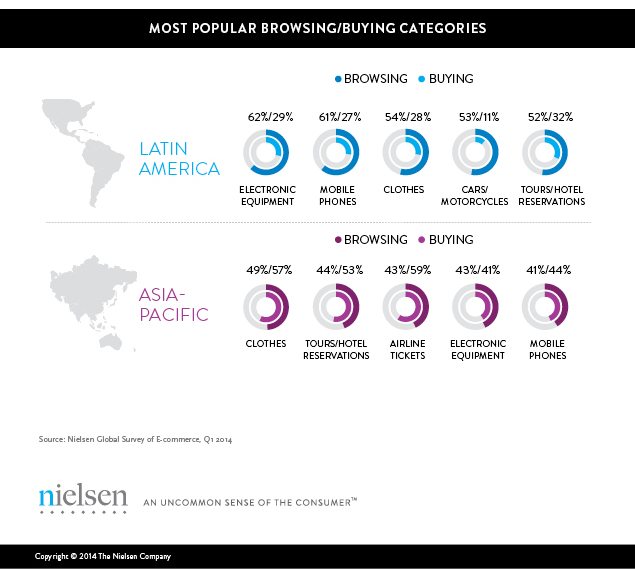With the internet user base reaching the third billion mark by the end by of 2014, more and more marketers are now clasping this lucrative platform to endorse their products, which in turn has proved to be the driving factor for the growth of e-commerce industry across the globe. The trade analysts have forecasted the Compound Annual Growth Rate (CAGR) of the global E-commerce platform to be 13.54 percent over the years 2013-2018, which depicts the strong hankering of the world population to shop on the WWW consortium. Although there has been a substantial increase in the range of products available online, for example Amazon claiming to offer one to all products from A to Z, yet for certain categories the conventional stores dominate the web cart.
According to a survey conducted by the Nielsen global on e-commerce, there exists a considerable disparity among the demand for the products available online and out of which the non-consumable durable and entertainment related products turned out to be the leader of the league. The survey outlined that the ratio of browsing to buying for such products like clothes, books and toys, booking hotels and flight tickets was almost one to one as compared to the consumable goods like the groceries, personal care products, alcoholic drinks etc. for which the same ratio came out to be 1:1.5 approximately. However, the domain of the latter mentioned consumable goods is yet termed to be fledgling in the online sector but the strong co-relation between the browse-to-buy ratios in the survey depicted the increasing trust of buyers on even consumable goods on this dais. Apart from these strong browse-to-buy correlating rate goods, some categories of products carrying a high price tag or requiring physical try out in the list of surveyed products like the sporting goods, electronic gadgets; computer related goods also accounted for creating more browsing sessions than the buying deals and the browse-to-buy difference for these products averaged about seven percent. Airline Tickets and Reservations was the only category in which the buying rates superseded the browsing rates.
In the next six months, online shoppers globally are intended to buy non-consumable product and travel tickets more than those of products from other categories. Nearly half of these shoppers are supposed to buy clothes or make an airline or hotel reservation. On the other hand, in spite of aggressive marketing groceries stores and consumable products are yet to find a sizable market online.
The Bridging Regions Of Browsers And Buyers
The developing nations of the world like China, India, Brazil and Japan are the greatest contributors of online search and browsing in the world and hence boast of providing a huge audience for e-commerce too, but there is a big demarcation line in the trend of online browsing between the two regions of Asia-Pacific and Latin-America. The survey deduced that although the online browsing sessions were highest for the Latin American region, but these nations were the staggers in terms of purchasing goods in almost every category of goods analysed. In contrast, the Asia Pacific region outperformed the former in terms of buying power with almost 14 out of 22 product categories under the survey consideration exceeding the buying rates than the browsing rates. The reason for the same can be attributed to the lack of availability of proper retail network and infrastructure in the Latin America hence limiting the realms of the e-commerce market. On the other hand Asia has proved to be the king in growth of online shopping and in 2014, 36.5% of worldwide B2C e-commerce sales is expected to be gleaned from the Asia-pacific region.
Another important factor which determines the elasticity of online shopping is the age of the consumers. The most preferred platform for the promoters are the social media networks and with more than 60% of its user base comprising of the Millennials (aged 21-34), this newer age group also dominates the e-commerce industry. This younger lot proportioned to 53% for buying a product online but the older generation was also not too far in this context and occupied a 40% share in the same segment.
Also with the increased number of online users logging through mobiles and tablets (about 25% of total user base), the marketers have tried to focus on the mobile shopping apps even to grab this large chunk of shoppers. In Asia-Pacific region 52% of the online shoppers preferred mobile for purchasing and in Latin America 48% of them intended for the same.
The sale of electronic commodities and entertainment categories have multiplied in recent times on the Internet, but the consumable goods on the web are also quickly gaining momentum like the baby products and fashion accessories. In a broader sense, the online transactions turn out to be handy for proliferating the shopping of non consumable goods, but when it comes to attract customers on grounds of consumable goods then it requires great marketing muscle. Hence maintaining a balance between the needs of the consumers for variety and value, whilst overcoming the negative perceptions like cost and shipping charges is essential for the enhanced and extended growth of the online shopping segment.



